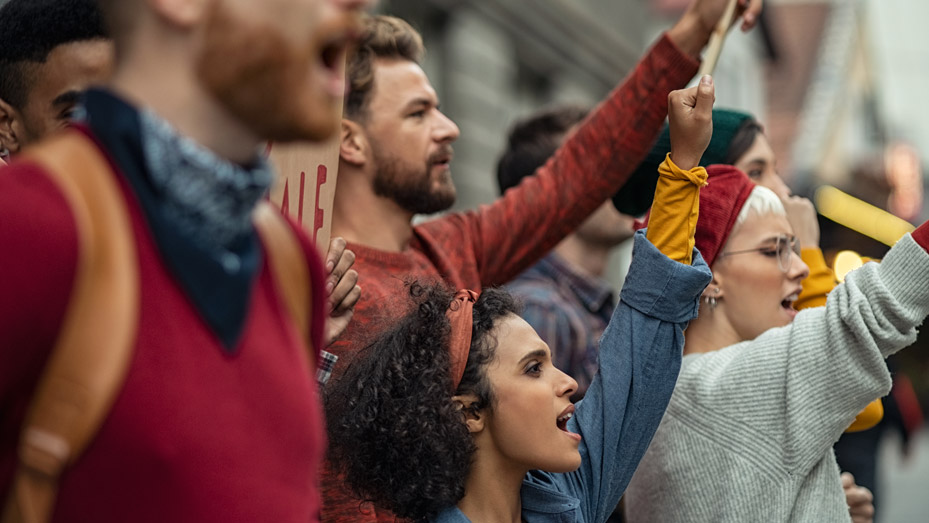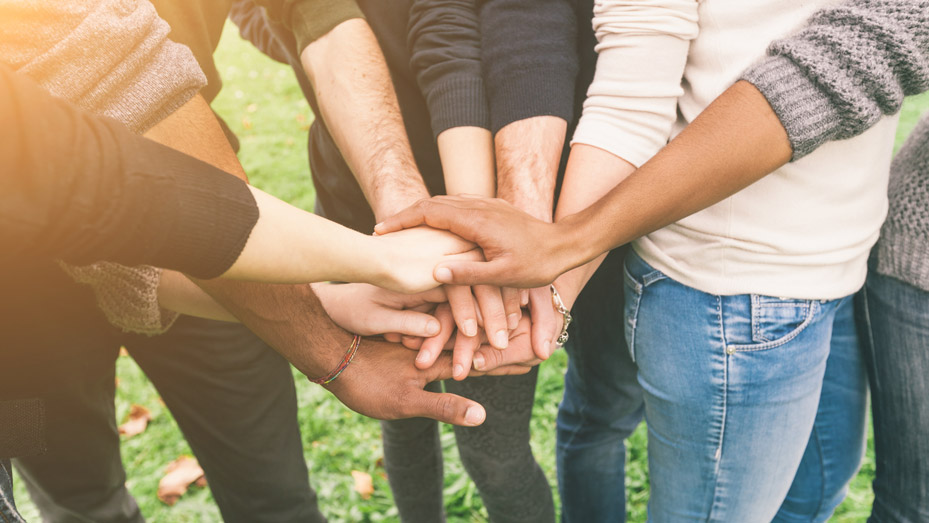Planning for Action
Building Relationships
Relationships are essential.
Ending gender-based violence (GBV) requires collective participation, leadership, and buy-in, all of which require meaningful relationships—relationships with individuals and groups, community members, youth, local leaders, government officials, policymakers, businesses, nonprofits, schools, faith leaders, and more. These relationships, when sustainable over time and grounded in shared interests, create change in our communities.
We must meet men where they’re at.
Meeting men “where they’re at”—in terms of their experiences, interests, culture, and spaces—is critical to build meaningful relationships. And, as in all relationships, including those with men, active listening, open communication, trust, appreciation for diversity in culture and thought, and respect are key elements to building relationships in communities.
Listening, communication, and trust build commitment.
Trust requires engagement in both directions. Learning about and participating in what is important to and valued by community members shows commitment to the overall health of the community. When engaging men, and other community members, participating in and celebrating the things that they value builds sustainable relationships with people working together towards shared values.
Questions to Consider
- Where do men meet and connect in your community?
- What relationships do you (your organizations, families, schools, and more) have with men across the community?
- What does it mean for you to meet men “where they are at” in your community?
Resources for Building Relationships

Principles of Community Engagement
RESOURCE TYPE: Report
AUTHOR: County Health Rankings and Roadmaps
YEAR: 2011
DESCRIPTION: Collection of resources including 9 key activities and 5 top tools designed to guide interested communities in building and sustaining partnerships to create change.

Building Movement Conversations
RESOURCE TYPE: Guide
AUTHOR: Move to End Violence
DESCRIPTION: Model for activists and leaders to have conversations that build energy and alignment towards a community vision for ending violence against women and girls.

Men Make a Difference: Engaging Men on Gender Equality
RESOURCE TYPE: Report
AUTHOR: Michael Flood and Graeme Russell
YEAR: 2017
DESCRIPTION: Report using evidence and experiences to create recommendations for how organizations can engage men to achieve gender equality at work.

Building Movement Conversations
RESOURCE TYPE: Guide
AUTHOR: Move to End Violence
YEAR: 2012
DESCRIPTION: Model for activists and leaders to have conversations that build energy and alignment towards a community vision for ending violence against women and girls.

Working Together
RESOURCE TYPE: Toolkit
AUTHOR: Centers for Disease Control and Prevention
YEAR: 2016
DESCRIPTION: Collection of resources breaking down key concepts and offering aligned tools to enhance collaboration when addressing community health issues.

What’s the Role of Men in Ending Patriarchy?
RESOURCE TYPE: Article
AUTHOR: Michael Flood
YEAR: 2017
DESCRIPTION: Article outlining general principles and 9 specific strategies for messaging and action to engage men in the movement to end patriarchy.
Community Engagement Continuum:
How to Move from Transactional Relationships to Shared Leadership

Reference: Modified by the authors from the International Association for public participation
Community Readiness Assessments
Assessment identifies points of engagement.
Assessing the awareness, receptiveness, and capacity of a community and ourselves to end gender-based violence (GBV) is an important step in planning for action. Identifying how prepared we are as communities, organizations, and individuals is critical to engage men meaningfully and sustainably.
Communities have different needs, resources, and readiness.
Let’s think about communities first. In a community where rates of gender-based violence are high and access to victim service resources are low, community members may not be ready to focus their time, energy and efforts to end GBV because their immediate need is support and resources to navigate the impact of victimization. Understanding the needs of the community, addressing their needs, and supporting their process to become ready to engage men in ending GBV will ensure successful outcomes in the work to engage men.
It’s critical to assess our own readiness, too.
Let’s go inward and think about personal readiness. As leaders, mentors, facilitators, and advocates for ending GBV, we have a responsibility to reflect upon and understand our own willingness to adopt new behaviors. We, too, live in a culture with systemic gender inequality and oppression that disempowers individuals based on gender, sexual orientation, sexual identity, race, disability, and more. Assessing, understanding, and shifting our personal attitudes, beliefs, language, and behaviors deepens our commitment and models social change among those we are building relationships with to end GBV.
Questions to Consider
- What information, support, or training do key community stakeholders need to take meaningful actions to to engage men?
- How prepared are you to work with men in your community? What level of understanding do you have of masculinity in the context of preventing and responding to GBV?
Resources for Conducting Community and Personal Readiness Assessments

Assess Needs & Resources
RESOURCE TYPE: Toolkit
AUTHOR: County Health Rankings and Roadmaps
YEAR: 2021
DESCRIPTION: Resource center guiding communities toward understanding their strengths, resources, needs, and gaps so individuals can decide where and how to focus their efforts.

Community Readiness Model
RESOURCE TYPE: Guide
AUTHOR: Tri-Ethnic Center for Prevention Research
YEAR: 2014
DESCRIPTION: Guide developed to teach communities how to identify their readiness level and develop stage-appropriate implementation strategies to match.

Community Assessments
RESOURCE TYPE: Toolkit
AUTHOR: Prevent Connect
YEAR: 2021
DESCRIPTION: Readiness Assessment tools for prevention specialists and providers to assess the needs of their community, including state specific examples and reports.

Understanding Masculinities & Violence Against Women and Girls
RESOURCE TYPE: Workbook
AUTHOR: UN Women Training Centre
YEAR: 2016
DESCRIPTION: Self-Learning Booklet aiming to build the learner’s understanding of the relationship between issues of masculinities and violence against women and girls to advance gender equality.

Assessing Community Needs & Resources
RESOURCE TYPE: Toolkit
AUTHOR: Center for Community Health and Development
YEAR: 2021
DESCRIPTION: Online toolkit with 24 sections designed to help users learn how to identify and assess community concerns, needs, and assets.

Assess Needs & Resources
RESOURCE TYPE: Toolkit
AUTHOR: Centers for Disease Control and Prevention
YEAR: 2016
DESCRIPTION: Collection of resources designed to describe how to effectively assess needs and resources in the community and among stakeholders.
Community Action Teams
Structure enables sustainability. Consistency enables trust
To build trust, our initiatives and collaboration must be sustainable and continuous. To create this sustainability, it’s essential to build teams of individuals from diverse sectors in communities who are willing to share power and resources around a common goal of engaging men to end GBV. We use the term Community Action Team (CAT) to describe this structure for engaged partners to come together with clear roles, responsibilities, and goals. Key partners can include: Community members; youth; local leaders; government officials; policy makers; businesses; nonprofits; schools; faith leaders; and more.
Teams create accountability for initiatives and opportunities for men to engage.
The work of the collective is not about coming to a meeting but coming together to develop action plans, facilitate initiatives, build engagement for programs, create campaigns to end GBV, and evaluate success. Full participation of engaged members supports community buy-in and critical connections across our communities. Additionally, these teams create clear pathways and roles for men to contribute their time, talent, and desire to be a part of the solution to end GBV, counteracting the narrative that men don’t want to be involved.
Diverse partnerships inform meaningful and informed initiatives.
Diversity in perspective and representation from the community on a Community Action Team can provide a deeper understanding of the men in your community, especially where they interact, what services they seek, and what challenges they navigate. The information can be helpful in your relationship building and program development. These partnerships also ensure that messaging and resources reach men who have been marginalized by our systems, such as GBTQ+ men.
Questions to Consider
- What relationships do you have with the various stakeholders in your community who work with men? Who do you believe is needed on the team?
- What clarity of purpose, structure, and roles can you implement on your CAT to ensure its success?
- Do you have a designated staff to provide continuous relationship building for your Community Action Team?
- What training or support does my team need to engage a diverse group of people (in terms of race, sexuality, and more)?
Resources to Support Community Action Teams

Work Together
RESOURCE TYPE: Toolkit
AUTHOR: County Health Rankings and Roadmaps
YEAR: 2021
DESCRIPTION: Collection of resources including 9 key activities and 5 top tools designed to guide interested communities in building and sustaining partnerships to create change.

Transformational Collaborations
RESOURCE TYPE: Guide
AUTHOR: Z. Ruby White Starr, Patricia Moen
YEAR: 2020
DESCRIPTION: Critical analysis paper bringing light to the ways in which POC and culturally specific organizations are marginalized and the importance of using a racial equity lens.

Guidelines for Funding Programs That Engage and Mobilize Men & Boys in Violence Prevention
RESOURCE TYPE: Guide
AUTHOR: Lana Wells, Michael Flood, Sophia Boutilier, Sharon Goulet, & Elizabeth Dozois
YEAR: 2020
DESCRIPTION: Guidelines for policy makers and funders of gender-based violence portfolios when investing in Engaging Men programs. Includes principles for teams establishing Engaging Men plans.
Strategic Planning
Vision requires reflection and structure.
Strategic plans are like a roadmap for a trip. They lay out our communities’ goals, activities to reach these goals, and who will facilitate those activities. Additionally, these plans detail projected outcomes and evaluation tools to measure success utilizing information learned during the community readiness assessments. Strategic plans should be developed in deep partnership with the community so that plans are created “by and for” the community as much as possible. This collective participation ensures realistic goals, activities, and outcomes and community support for the implementation of activities to engage men to end GBV.
Our efforts must be adaptable and sustainable.
Reviewing and adjusting the plan while implementing and facilitating programming is a critical process. Think about that cross country trip again. If you reach a road that is closed for repairs, the map helps you determine another road that will help you continue on your journey and reach your destination. The same is true for strategic plans. For Engaging Men, when challenges inevitably arise such as resistance or staff turnover, it’s critical to have established meaningful relationships to maintain progress and ensure adjustments incorporate diverse input.
Questions to Consider
- In what ways can you integrate diverse community representation into the strategic planning process?
- What change does your community want to see in 5, 10, or 20 years? How can your plan reflect an achievable path to get there?
Resources for Strategic Planning

Make a Plan
RESOURCE TYPE: Toolkit
AUTHOR: National Forum on Youth Violence Prevention
YEAR: 2012
DESCRIPTION: Toolkit covering the four-steps of making a plan to end youth violence: build partnerships and raise awareness; gather and use data to inform strategies: write the plan; implement the plan.

Training for Strategic Planning
RESOURCE TYPE: Course Offerings
AUTHOR: Technology of Participation
YEAR: 2021
DESCRIPTION: Two day course designed to weave ToP Facilitation Methods into a strategic planning approach, resulting in strong consensus around an achievable and measurable plan.

Connecting the Dots
RESOURCE TYPE: Report
AUTHOR: Centers for Disease Control and Prevention
YEAR: 2016
DESCRIPTION: Report outlining how intersectional, cross-cutting strategic plans focusing on different risk and protective factors that contribute to violence can support coordinated responses.
